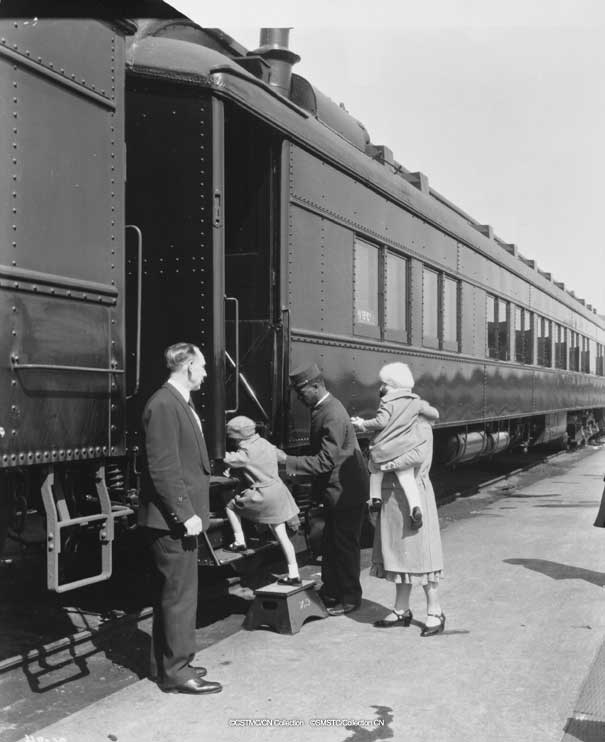Take a Moment...
00:00"A CN Porter Assisting Two Children Board a Train." n.d. Black and white photograph. Canadian Science and Technology Museum Collection, Image No.: CN005805. (Photograph courtesy of © Canada Science and Technology Museum Archives). (Source)
"George," Who?
Text by: Dereje Taye (Reference Assistant) and Rachel Harris (Librarian)
"A CN Porter assisting two children board a train" (no date) is one amongst several professional photographs of everyday scenes on the Canadian National Railway. There is more to the staging of this typical day in the 1930s or 1940s of two children boarding a train. The image shows a white man in a tuxedo jacket, who is presumably the supervisor, overseeing that a family is getting excellent service in a sleeper wagon with the Black sleeping car porter at their beck and call. While the children and their mother prepare for departure: the step stool is brought forth so that the first child can easily climb aboard; "George" the porter extends a hand of support. As the mother holding her younger girl waits for the older one to board, the porter is cast in their shadow—fading in his generic uniform into the background of the shiny black exterior of the train itself.
Named after the American engineer and industrialist George Pullman (1831-1897), the Pullman sleeper cars that traversed Canada’s railway network bring to light the inequalities experienced by Black persons in Canada’s coast-to-coast history of racism. Podcasts and encyclopedia articles are finally bringing to light how the railway in the USA and then in Canada hired freed slaves, and later in the Canadian context, Blacks from the Caribbean, Halifax, Montreal, and Toronto were also a source of inexpensive labour on the Pullman sleeping cars (Oyeniran 2019; Simone Bowen and Johnson 2019). In 1870, shortly after confederation in Canada, these sleeping cars created a space of Black labour at the service of white luxury. The Pullman sleeping car business model was designed to provide an exceptional travel experience for the passengers, the majority of whom were likely white middle- to upper-class passengers, who had their shoes shined, beds made, and dinner served. Meanwhile, the Black sleeping car porters were at the disposal of the passengers at all hours during the overnight trips (Simone Bowen and Johnson 2019). With the Pullman model of sleeping cars, the railway industry became a turning point between yesteryear’s enslavement and post-American Civil War era of employment for the Black communities in North America.
The work-life of sleeping car porters, many of whom were educated well beyond the requirements of their employment, was readily demeaning by the extent of their service to white passengers and by how they were called. The name "George" taken after George Pullman was a name that all Black sleeping car workers were referred to (Oyeniran 2019). Following the custom where freed slaves took on the name of their master, the generic name of George enforced the inequalities in the railroad service. Denied the sound of their own names, to the call of "George," they were available and responsive to railway customers at any time to shine shoes, carry luggage, and so forth. With the lingering residue from slavery, the Black sleeping car porters worked long hours, were paid less than their white coworkers, were disciplined harshly, and were denied many labour benefits—vacation, proper rest, promotion, union access, and salary increases—and could be fired at a whim (Oyeniran 2019; Simone Bowen and Johnson 2019). Such discriminatory labour standards are counter to basic human rights and the respect of individual identities.
Despite the fear of speaking out, by 1942, Black Sleeping Car Porters (BSCP) formed their own group, met in secret, fought for better working conditions, and recognition (Oyeniran 2019). By the first collective agreement in 1945, the BSCP made a significant concession to have plaques with names inscribed and mounted in the sleeping cars that the porters served (ibid). The mounted plaques would clearly identify the person in their workplace giving the porters recognition and dignity in their place of employment and eventually in Black Canadian history. Sleeping Car Porters—Judge Stanley G. Grizzle, Rufus Rockhead, Asa Philip Randolph and Milton P. Webster, Calvin Ruck—would make a difference in the areas of immigration law, workers’ rights, politics, unions, culture, and the future of the nation.
"George, who?", the Black porter in the photograph is an essential link from the past toward the possibility of a more progressive future of equality and freedom. The train with its glistening windows and shiny steel will take off and move into the distance, but where to? This future needs to be one where the racialized dynamic in Canada is not whitewashed, but rather one where the story of Black resilience and ongoing struggle is made part of a shared narrative.
For more about the Pullman sleeping car porters
Brown, James. n.d. "The Pullman Spirit Lives On." CN Rail Tours. Accessed 28 April 2021.
Kersten, Andrew E., and Clarence Lang. 2015. Reframing Randolph: Labor, Black Freedom, and the Legacies of A. Philip Randolph. New York: NYU Press.
Oyeniran, Channon. 2019. "Sleeping Car Porters in Canada." In The Canadian Encyclopedia. Last modified 19 Feb. 2019.
Simone Bowen, Leah, and Falen Johnson. 2019. "The Province of Jamaica." Secret Life of Canada | CBC Radio. Accessed 28 April 2021.
Take a Moment for Representation: An Anti-Racism Series
We are proud to present Concordia University Library's inaugural digital exhibition. Take a Moment presents a series of un-interrupted moments for solidarity with the Black Lives Matter movement, for reflection on systemic racism, and for making space for Black representation. At this exact moment in time, let us pause for a minute, or two, or more...
Take a Moment Coordinators: Rachel Harris and Sarah Lake
Questions? Please contact: lib-exhibitions@concordia.ca


